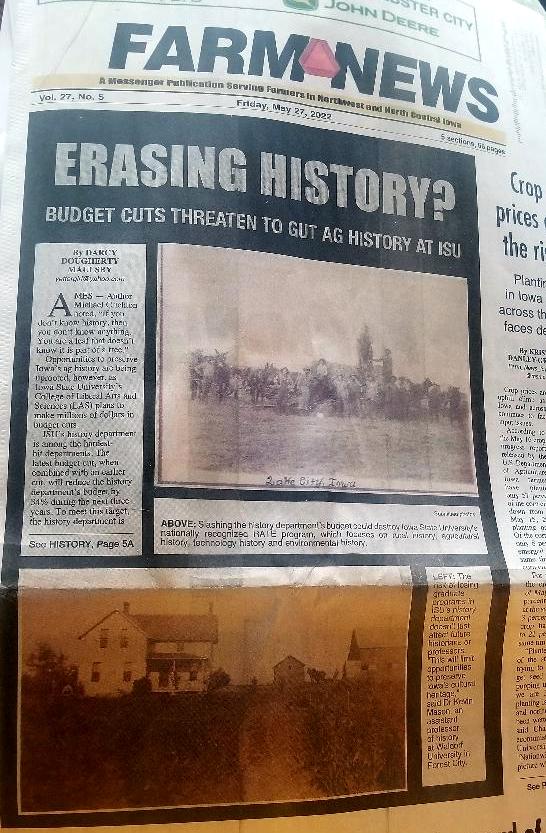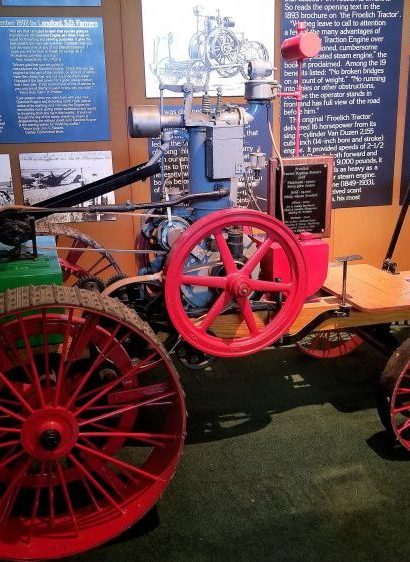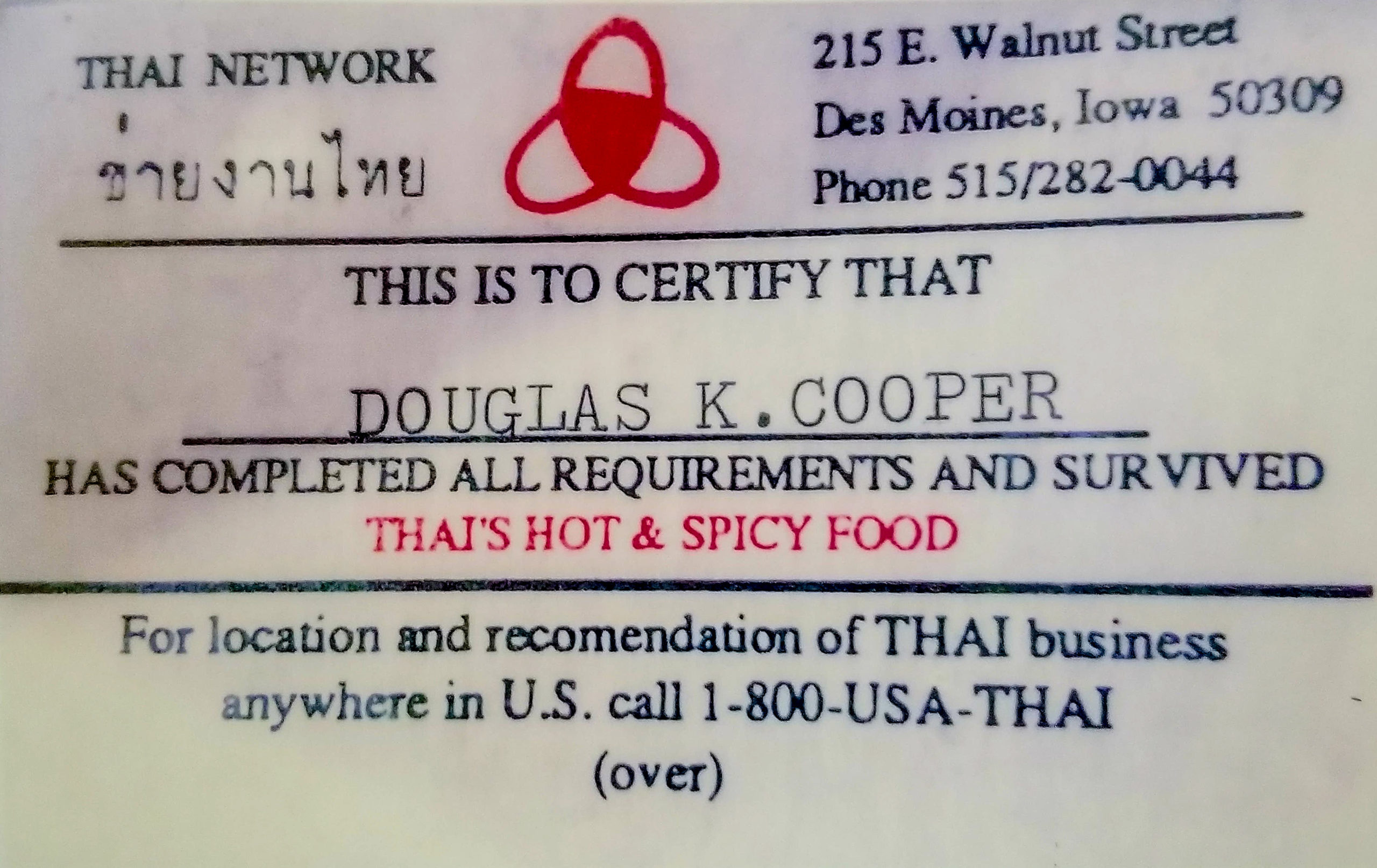
Whats HOT
Latest Posts
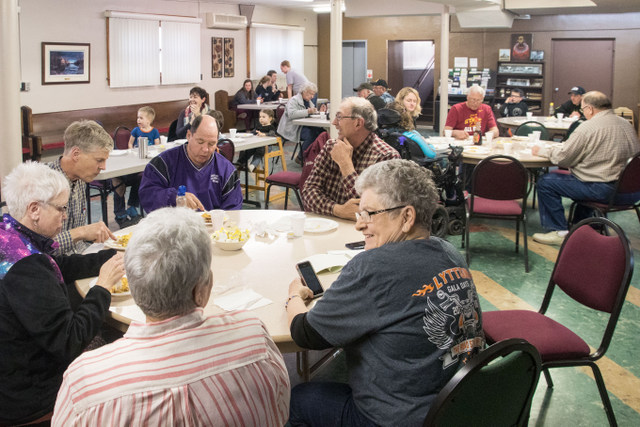
Doing Good, Eating Good at Lytton Town Night
What’s the glue that keeps a community connected? Around Lytton, Iowa, it’s food and fun at Lytton Town Night–and the homemade pie, of course.
While Lytton, Iowa, celebrates Gala Days each year during Memorial Day weekend, planning and fundraising for this beloved 100+ year tradition starts months earlier. In fact, a key part of the process starts in that most iconic of all small-town gathering places—the church basement.

Emanuel-St John Lutheran Church in Lytton, Iowa, hosts Lytton Town Night meals throughout the winter.
The basement dining area at Emanuel-St John Lutheran Church, whose congregation has roots dating back to 1883, provides a convenient setting for Lytton Town Night, which is held each Thursday evening from mid-January through March. Each Town Night offers a unique opportunity for the community to come together for free-will-donation meal to raise money for various causes and organizations, including Gala Days.
“Town Night is great, because there are a lot of fabulous cooks around Lytton,” said Nelda Bartels, a lifelong Lytton-area resident who often volunteers at Town Night.
As word of Town Night has spread through the years, guests come not only from Lytton, but Lake City, Sac City, Rockwell City and beyond. It’s not uncommon to serve a few hundred people at each meal.
“It’s like one big family when everyone gets together,” said Wendy Miller with the Lytton Chamber of Commerce.
Lytton Town Night includes groups like the Gala Days volunteers, the South Central Calhoun FFA chapter, 4-H clubs, civic groups and individuals raising money for worthy causes, including overseas mission trips. The Lytton Chamber of Commerce coordinates the schedule for Town Night, which allows eight to 10 different groups and individuals to host a Town Night meal during the winter, complete with home-cooked food. Some groups serve a selection of pasta casseroles, while others like the local FFA members serve pancakes and sausage links.
“I like the food, because it’s all good,” said Randy Souder, a Lytton-area farmer. “It’s also affordable, so everyone can come.”
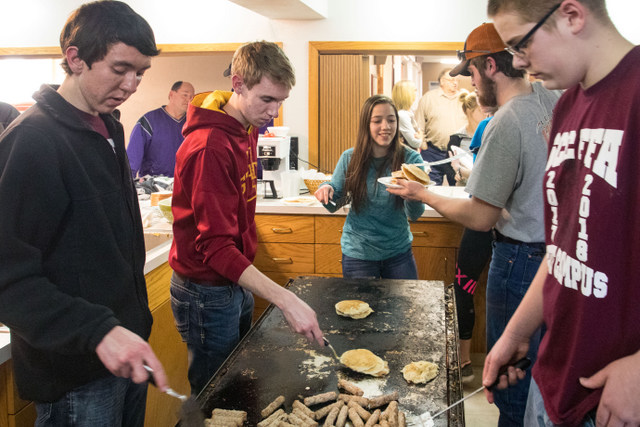
Members of the South Central Calhoun FFA chapter cooked pancakes and sausage during a Lytton Town Night fundraiser.
While no one is quite sure when Lytton Town Night started, it has been around since at least 1980, according to local-time residents. “It’s such a fun event, because you get to visit with friends and neighbors you don’t always see,” said Marlene Glasnapp, who lives with her husband, Roger, on a farm south of Lytton and is known as one of the best pie bakers in the area.
Each Town Night event is promoted through the Lytton Town Crier and on social media through Facebook. Each meal runs from 5 p.m. to 7 p.m. each Thursday evening during the winter. The popular gatherings attract people of all ages, from babies to grandparents.
Some groups, like the Gala Days volunteers, serve a lunch and a dinner meal when it’s their turn to host Town Night. “We usually have casseroles and homemade pie,” Bartels said. “The homemade pie is the kicker, because it’s always a hit.”
When the meal is done, the fellowship continues in downtown Lytton at the 1950s-era American Legion hall for bingo. “Town Night bingo has been called Lytton’s winter sport,” Bartels said.
The evening of bingo lasts about an hour and a half, and participants can play as many cards as they want. Two cards cost $3, and the proceeds support the American Legion.
Town Night isn’t just a fun evening, added Brian Lantz, an ag instructor at South Central Calhoun High School who advises the local FFA chapter. “It’s a local tradition, plus the kids learn how to work with the public when it’s their turn to cook and serve the meal.”
Keeping the Town Night tradition alive is important to residents of Lytton, which has a population of 302 residents. “Every year we wonder if we’ll be able have Town Night again,” Miller said. “We’re going to keep it going as a long as we can.”

Creamy Chicken Pasta Casserole
Creamy Chicken Casserole
This simple, hearty dish from Nelda Bartels of Lytton was served at the Gala Days fundraiser at Lytton Town Night in March 2018.
3 boneless, skinless chicken breasts, cooked and shredded
1 teaspoon garlic powder
1 tablespoon olive oil
1 10.75-ounce can cream of chicken soup
1 10.75-ounce can cream of mushroom soup
1 cup milk
1 bag (2 cups) shredded Cheddar cheese
1 / 2 teaspoon ground black pepper
1-pound box elbow macaroni (cooked according to package directions)
1 1 / 2 cups panko bread crumbs or regular bread crumbs
Preheat oven to 350 degrees. Cook chicken with garlic powder. (Nelda uses a programmable pressure cooker and adds a couple cups of chicken broth.) Drizzle with olive oil. When done, shred chicken with a fork, and save the juice.
Combine the two cream soups, milk, cheese, cooked chicken, broth from chicken and pepper. (If desired, add some sour cream or cream cheese into the mixture for extra flavor and creaminess.) Add cooked macaroni. Stir the mixture and pour into a 9-inch by 13-inch casserole pan.
Top casserole with panko breadcrumbs. Bake at 350 degrees for 20 to 25 minutes. Brown panko topping under broiler on low for 3 to 5 minutes. Watch closely, since the breadcrumbs can burn quickly.
Bowtie Lasagna Casserole
This tasty recipe comes from Nelda Bartels of Lytton.
1 jar spaghetti sauce
1 to 1.5 pounds ground beef
1 package bowtie pasta noodles (cooked according to package directions)
1 small carton cottage cheese
1 8-ounce package cream cheese
1 small carton sour cream
Mozzarella cheese
Preheat oven to 350 degrees. Brown hamburger; mix with spaghetti sauce. Pour sauce on bottom of 9-inch by 13-inch baking pan. Combine hamburger and bowtie pasta. Combine cottage cheese, cream cheese, and sour cream. Add to hamburger/pasta mix; pour in baking pan. Top with mozzarella cheese.
Bake at 350 degrees for 45 minutes to 1 hour.
Poppy Seed Chicken
This recipe comes from Susan Albright of Lytton.
4 chicken breasts, cooked and cubed
1 carton (16 ounces) sour cream
1 10.75-ounce can cream of chicken soup
Very small handful of spaghetti, broken into pieces and cooked (Susan Albright uses three fourths of a box of angel hair pasta)
1 stick butter
40 Ritz crackers, crushed
1 / 2 tablespoon poppy seeds
Preheat oven to 350 degrees. After cooking chicken, season to taste with garlic salt and onion. Combine sour cream and soup. Add cubed chicken and cooked spaghetti to mixture. Add salt, to taste.
Pour mixture into greased, 9-inch by 13-inch baking dish.
In a separate bowl, melt butter; add crushed crackers and poppy seeds. Sprinkle cracker mixture on top of casserole. Bake for 20 minutes.
Pie Crust
For decades, Marlene Glasnapp of rural Lytton has relied on this recipe, which yields approximately 6 crusts per batch.
5 cups flour
1 teaspoon salt
1 pound lard
1 cup water
Combine flour and salt. Cut lard into the flour mixture. Add water, a little at a time, mixing quickly and evenly until dough just holds together in a ball. Divide dough for six crusts. (The crusts can be frozen for later use, and Marlene often rolls hers out before freezing.)

Raisin Cream Pie
Marlene Glasnapp’s raisin cream pie is always a hit wherever it’s served.
1 cup granulated sugar
3 tablespoons flour
1 / 2 teaspoon salt
1 teaspoon cinnamon
2 cups half-and-half
3-4 egg yolks (depends on the size of the eggs)
1 cup raisins
Mix dry ingredients with 1 / 2 cup of half-and-half, and set aside. Whisk egg yolks, and combine remaining half-and-half with the yolks. Add this mixture to the pie filling mix you set aside earlier.
Add raisins to the mixture and stir over medium heat until thick. Cool slightly. Pour in baked pie shell and top with meringue.
Meringue
1 tablespoon cornstarch
1 / 2 cup plus 1 tablespoon water
3 to 4 egg whites (depending on the size of the eggs)
3 to 4 tablespoons granulated sugar
Dissolve 1 tablespoon of cornstarch in 1 tablespoon of water. Boil 1 / 2 cup water and add to cornstarch mixture. Cook until clear. (This can be done in the microwave.) Beat egg whites and gradually add sugar. Add cooled cornstarch mixture and beat to proper consistency. Spread meringue over top of pie, sealing to the edge. Bake pie at 350 degrees Fahrenheit until meringue has browned.
Note from Darcy: I first wrote this piece in 2018 for Farm News.
Want more?
Thanks for stopping by. I invite you to read more of my blog posts if you value intriguing Iowa stories and history, along with Iowa food, agriculture updates, recipes and tips to make you a better communicator.
If you like what you see and want to be notified when I post new stories, be sure to click on the “subscribe to blog updates/newsletter” button at the top of this page, or click here. Feel free to share this with friends and colleagues who might be interested, too.
Also, if you or someone you know could use my writing services (I’m not only Iowa’s storyteller, but a professionally-trained journalist with 20 years of experience), let’s talk. I work with businesses and organizations within Iowa and across the country to unleash the power of great storytelling to define their brand and connect with their audience through clear, compelling blog posts, articles, news releases, feature stories, newsletter articles, social media, video scripts, and photography. Learn more at www.darcymaulsby.com, or e-mail me at yettergirl@yahoo.com.
If you’re hungry for more stories of Iowa history, check out my top-selling “Culinary History of Iowa: Sweet Corn, Pork Tenderloins, Maid-Rites and More” book from The History Press. Also take a look at my latest book, “Dallas County,” and my Calhoun County” book from Arcadia Publishing. Both are filled with vintage photos and compelling stories that showcase he history of small-town and rural Iowa. Order your signed copies today! Iowa postcards are available in my online store, too.
Let’s stay in touch. I’m at darcy@darcymaulsby.com, and yettergirl@yahoo.com.
Talk to you soon!
Darcy
@Copyright 2018 Darcy Maulsby & Co. Blog posts may only be reprinted with permission from Darcy Maulsby.
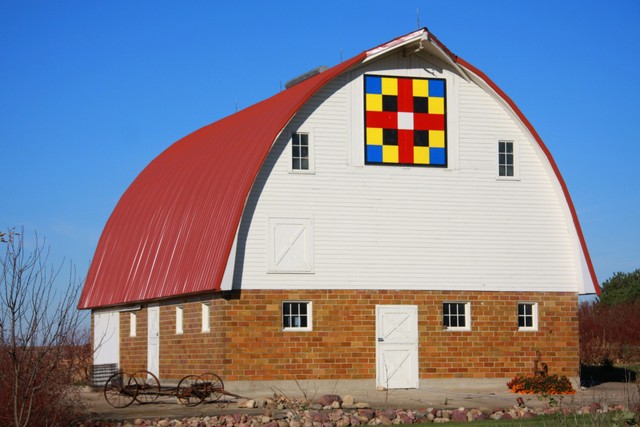
Sac County Barn Quilt Attracts National Attention
When Alvin (Al) Liske and his wife, Jean, signed up for the Barn Quilts of Sac County project, they had no idea how much attention this would attract to their stately World War II-era barn west of Early, Iowa.
“Our barn has been featured in Eleanor Burns’ book, ‘Quilt Blocks on American Barns,’ and it was also included on the cover of the Department of Transportation’s 2009 map of Iowa,” said Jean.
Burns, a popular television personality who gained famed for her “Quilt in a Day” system, visited the Liske barn last year when she traveled to Iowa to participate in the Sac County Quilt-a-Fair. She was especially intrigued by the Country Lanes barn quilt pattern that graces the barn’s haymow door. She noted that Country Lanes is a very old pattern that was originally published by Mountain Mist, a company that began selling quilt batting in Cincinnati in 1846.
“We chose the Country Lanes block, because we live on a gravel road,” said Jean, who works in the registrar’s office at Buena Vista University in Storm Lake. “Even though we’re off the beaten path, it’s not uncommon to see people drive out here and take photos of the barn.”
Jean’s father, Herman Puetz, built the barn for approximately $4,000 around 1943 or 1944 on the Boyer Valley Township farm that his family had purchased in 1930. The new barn replaced an existing barn that was made from cottonwood lumber. After the concrete foundation for the new barn was poured, lumber was not readily available for the building, due to the war. In the meantime, the family roller skated on the concrete slab. “When construction started again, I can also remember going with my parents to Albert Lea, Minn., to get the rafters for the barn, and I thought that was a really long trip,” said Jean, who noted that the barn includes glazed tile on the bottom and originally had wood shingles on the rounded, gothic roof.
Herman kept horses in the barn, said Jean, who added that farming with horses could be dangerous. “One time when my Uncle George was hauling manure on our farm, something spooked the horses, and they ran toward a barbed wire fence. My uncle jumped off, and he broke his ankle, which got infected.”
Jean’s father, who was one of 12 children, also milked cows on the east side of the barn and kept plenty of hay in the haymow. “I’d play in the barn with my brothers and sister, and we’d make tunnels and caves and houses with the bales. When enough hay had been fed, there would be bare spots in the haymow, and we’d play basketball up there,” said Jean, who noted that the haymow still includes basketball hoops.
After Jean married Al and the couple moved to the farm where Jean grew up, the Liskes raised cattle and hogs in the barn and farmed from the early 1960s until the 1980s. In 2005, the couple decided to remodel the barn, which still had a good foundation. “It was getting to the point where we needed to fix up the barn or think about tearing it down, and we didn’t want to watch the barn fall down,” said Jean, who noted that the family power washed the interior, rebuilt windows and doors, had the barn rewired, covered the roof with red steel and added a staircase to the haymow.
The barn, which is now used for storage, became
a favorite play area for the Liske’s grandchildren. “The barn is an important part of our family’s heritage, and it’s one of the few old buildings left on this farm,” Jean said. “My dad was always proud of the barn, and we’re glad we’ve maintained it.”
Note from Darcy: I first wrote this piece in 2010 for Farm News.
Want more?
Thanks for stopping by. I invite you to read more of my blog posts if you value intriguing Iowa stories and history, along with Iowa food, agriculture updates, recipes and tips to make you a better communicator.
If you like what you see and want to be notified when I post new stories, be sure to click on the “subscribe to blog updates/newsletter” button at the top of this page, or click here. Feel free to share this with friends and colleagues who might be interested, too.
Also, if you or someone you know could use my writing services (I’m not only Iowa’s storyteller, but a professionally-trained journalist with 20 years of experience), let’s talk. I work with businesses and organizations within Iowa and across the country to unleash the power of great storytelling to define their brand and connect with their audience through clear, compelling blog posts, articles, news releases, feature stories, newsletter articles, social media, video scripts, and photography. Learn more at www.darcymaulsby.com, or e-mail me at yettergirl@yahoo.com.
If you’re hungry for more stories of Iowa history, check out my top-selling “Culinary History of Iowa: Sweet Corn, Pork Tenderloins, Maid-Rites and More” book from The History Press. Also take a look at my latest book, “Dallas County,” and my Calhoun County” book from Arcadia Publishing. Both are filled with vintage photos and compelling stories that showcase he history of small-town and rural Iowa. Order your signed copies today! Iowa postcards are available in my online store, too.
Let’s stay in touch. I’m at darcy@darcymaulsby.com, and yettergirl@yahoo.com.
Talk to you soon!
Darcy
@Copyright 2018 Darcy Maulsby & Co. Blog posts may only be reprinted with permission from Darcy Maulsby.
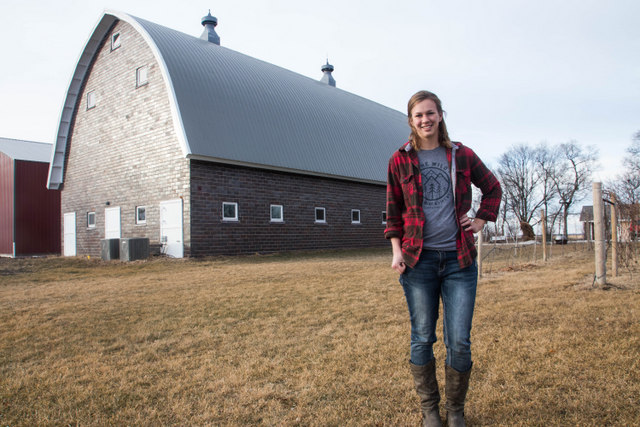
Events Spark Stories That Help Backcountry Winery Grow in Iowa
Ask Amber Gable about the back story behind Backcountry Winery at her family’s home east of Stratford, and her answer is straightforward. “It’s a hobby out of control.”
That hobby has taken Gable and her husband, Preston, on dynamic journey that has led to the creation of a small business that’s helping spur economic development in rural Iowa. At the heart of it all is a century-old barn that’s central to the story, offering an attractive venue for gatherings, celebrations, music concerts and more.
“This barn is such a unique building,” said Amber Gable, 27, who grew up on a farm near Sibley. “There’s so much history here, including original interior boards that have Stratford Grain and Supply stamped on them.”

Beyond the tasting room on the main floor, the barn loft holds 150 people.
Guests who come to Backcountry Winery for bridal showers, wedding receptions, class reunions and other celebrations enjoy exploring this rural heritage. So do the visitors who stop by for Backcountry Winery’s live music events.
“When we’re open on Saturday afternoons without a special event like live music, we tend to have smaller crowds,” Gable said. “Events help create experiences that people seek out.”
Events of all types have become an increasingly important part of running a successful winery, noted Mike White, a viticulture specialist for Iowa State University Extension. “More wineries are realizing that there’s big potential in event centers, and many are going this way.”
Putting down roots in Hamilton County
For many guests, part of the experience involves learning the story of the winery. In the case of Backcountry Winery, that story began with Preston Gable’s long-time interest in home winemaking.
“We’d talk about how we might open a winery someday,” said Amber Gable, whose husband is a fellow northwest Iowa native from Hartley.
“Someday” seemed far off, however, when the high school sweethearts started their careers in Ames following their graduation from Iowa State University (ISU). Amber Gable became a landscape designer for an engineering firm, while her husband worked in biofuels research at ISU.
When the couple began looking for an affordable acreage in central Iowa where they could establish a home, start a family and maybe operate a winery eventually, the process became frustrating at times. “We actively looked for about a year and often came up with nothing,” Amber Gable said. “There were some tears along the way.”
Things turned around in 2014, though, when the young couple found an acreage with a house and barn northeast of Stratford. “We really needed a fixer-upper, and this place needed a family to put down roots,” Amber Gable said.
After the couple purchased the property in August 2014, they began remodeling the barn within a few months and exploring its history. The abstract for the property goes back to 1920, when the current home on the acreage was built by Alfred Erickson. “We know the barn pre-dates 1920, although we don’t know exactly when it was built,” Amber Gable said.
While the barn is structurally sound, time had taken a toll on some parts of the building. “We poured a new concrete floor and replaced the entire hayloft floor,” said Amber Gable, who noted that the barn once housed cattle.
After months of work, the Gables opened Backcountry Winery in May 2016. “The barn is still a work in progress, but it has allowed us to open our winery sooner than we anticipated,” said Amber Gable, who appreciates the opportunity to run a home-based business, especially now that she and her husband are raising their 1-year-old son, Ivan.
Word-of-mouth marketing, Backcountry Winery’s website and a Facebook page have helped the couple’s business grow. While Backcountry Winery hosted one wedding in 2016, this grew to five weddings in 2017 and has increased to seven weddings slated for 2018.
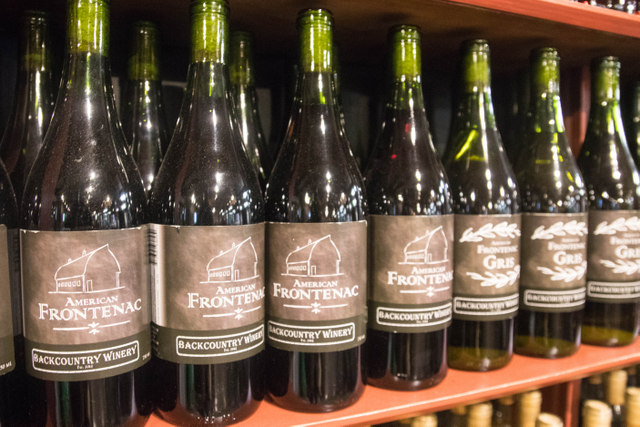
At Backcountry Winery, the Gables grow six varieties of wine grapes. They make 12 different wines, including strawberry, raspberry, cherry and apple wines, and plan to expand to 14 wines soon.
The Gables have invested in an expansion near the barn to accommodate these events. A connecting space on the west side of the barn will include a room when brides can get ready for their wedding. This connecting space is attached to a 60-foot by 90-foot addition that will provide additional production space, storage space and office space for the winery.
This infrastructure is just one part of Backcountry Winery’s recent expansions. While the Gables maintain a vineyard on the east side of the barn, the couple also began leasing an established, 4-acre vineyard near Webster City in the spring of 2017.
“It’s exciting to raise more of our own grapes so we can produce estate wines, which are made from our own crop,” said Amber Gable, who is a member of the Iowa Wine Growers Association. “There’s a great deal of pride in that.”
Wine wins big at Iowa State Fair
This pride is reflected in the large, silver trophy that graces the barn at Backcountry Winery. When the Gables competed in the commercial wine competition at the 2017 Iowa State Fair, the judges selected Vignoles from Backcountry Winery for the top honor, the Governor’s Cup. Vignoles is a semi-dry white wine that boasts crisp flavors of tropical and citrus fruits and a clean finish.
Vignoles is just one of the wines available from Backcountry Winery, where the Gables grow six varieties of wine grapes. They make 12 different wines, including strawberry, raspberry, cherry and apple wines, and plan to expand to 14 wines soon.
Backcountry Winery’s products can be purchased at the winery or through the approximately 25 retailers in Hamilton County and central, northern and northwest Iowa that partner with Backcountry Winery.
Raising specialty crops like wine grapes and offering Iowa wines offer unique opportunities to boost economic development in rural Iowa, Amber Gable said. “When visitors come to our winery, they not only buy wine, but they buy fuel at the convenience store in Stratford, which is owned by the local co-op, and they can go to Stanhope to get a burger. It’s rewarding to promote the whole Hamilton County experience.”
The Gables hope to attract more guests to the area by offering more live music this summer at the winery. This builds on the success of the three performances offered in 2016 and the 10 shows offered in 2017. The 2018 concerts, which range from country to classic rock, cost $5 for admission and will be held on certain Saturdays from 6 p.m. to 8 p.m. in the barn.
“Visiting a winery is all about the experience,” Amber Gable said. “We enjoy creating these memorable experiences, meeting people from across Iowa and beyond and promoting rural Iowa.”

When the Gables competed in the commercial wine competition at the 2017 Iowa State Fair, the judges selected Vignoles from Backcountry Winery for the top honor, the Governor’s Cup. Vignoles is a semi-dry white wine that boasts crisp flavors of tropical and citrus fruits and a clean finish.
Iowa’s Wine Industry, By the Numbers
Data from the Iowa Wine Growers Association (IWGA) shows that Iowa has:
• 103 wineries
• 267 vineyards
• 1,300 acres of grapes
• 8 wine trails
• 40+ cold-climate grapes grown
• $420 million of economic impact in 2012
• 2,600 full-time jobs
• 358,000 wine related tourists per year
On average, the typical Iowa winery produces approximately 3,000 gallons of wine annually. The Iowa native wine industry helps promote and establish additional activity in the state, including lodging, food, travel, gifts, agri-tourism, event centers, festivals, music, art and a host of service industries.
“By our estimation, based on direct feedback from the wineries we surveyed, there was over $2.1 million in revenue generated from these wine-related events and facilities,” according to the 2012 “Economic Impact of Iowa Wine and Wine Grapes” report produced by Frank, Rimerman + Co, LLP.
In order for the industry to keep growing and attracting new visitors, wineries not only need to continue focusing on improving wine quality, but consider expanding into more wine-related events like private parties, weddings and festivals held on winery properties, according to the report.
- I originally wrote this story for the Progress section of Farm News, Ft. Dodge, Iowa in February 2018.
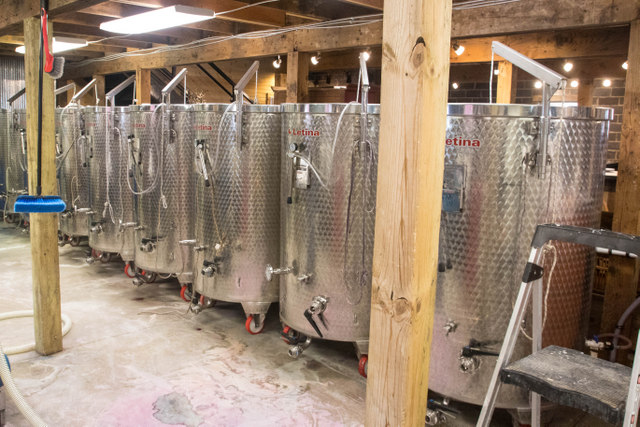
Backcountry Winery’s fermenting equipment is housed in a Hamilton County, Iowa, barn that’s approximately 100 years old.
Want more?
Thanks for stopping by. I invite you to read more of my blog posts if you value intriguing Iowa stories and history, along with Iowa food, agriculture updates, recipes and tips to make you a better communicator.
If you like what you see and want to be notified when I post new stories, be sure to click on the “subscribe to blog updates/newsletter” button at the top of this page, or click here. Feel free to share this with friends and colleagues who might be interested, too.
Also, if you or someone you know could use my writing services (I’m not only Iowa’s storyteller, but a professionally-trained journalist with 20 years of experience), let’s talk. I work with businesses and organizations within Iowa and across the country to unleash the power of great storytelling to define their brand and connect with their audience through clear, compelling blog posts, articles, news releases, feature stories, newsletter articles, social media, video scripts, and photography. Learn more at www.darcymaulsby.com, or e-mail me at yettergirl@yahoo.com.
If you’re hungry for more stories of Iowa history, check out my top-selling “Culinary History of Iowa: Sweet Corn, Pork Tenderloins, Maid-Rites and More” book from The History Press. Also take a look at my latest book, “Dallas County,” and my Calhoun County” book from Arcadia Publishing. Both are filled with vintage photos and compelling stories that showcase he history of small-town and rural Iowa. Order your signed copies today! Iowa postcards are available in my online store, too.
Let’s stay in touch. I’m at darcy@darcymaulsby.com, and yettergirl@yahoo.com.
Talk to you soon!
Darcy
@Copyright 2018 Darcy Maulsby & Co. Blog posts may only be reprinted with permission from Darcy Maulsby.
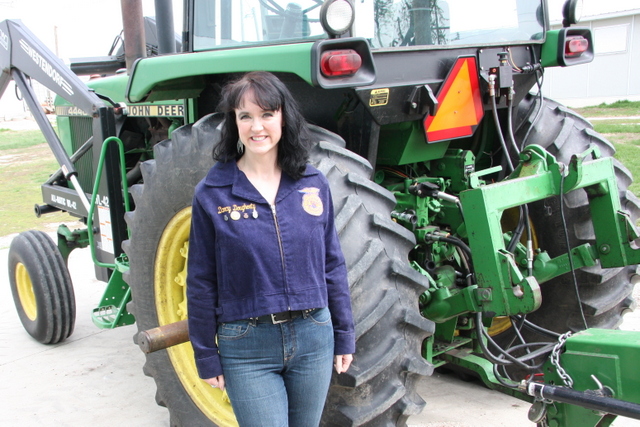
Recalling a Most Unconventional—and Life-Changing–FFA Journey
My FFA story is so unlikely that even I can’t quite believe it myself. It all began in the fall of 1989, when I was starting my sophomore year at Southern Cal High School in Lake City.
As a child of a Farm Crisis, I never thought about joining FFA. I was busy with classes, band, choir, theater and other activities, and the unspoken message was clear—ag has no future, so don’t spend your time there. Then along came Ed Ricks.
Ed was Southern Cal’s ag teacher and FFA advisor. Turns out he was also a talent recruiter. He asked me whether I’d be interested in coming over to the ag building and studying ag rather than taking the standard 10th grade biology class. I was intrigued. Ed worked out an arrangement with the biology teacher so I could skip biology class every day and instead focus on ag, as long as I could pass the biology tests.
No problem.
What a golden opportunity this turned out to be. I discovered a whole new world of learning, plus I didn’t have to be bored in a biology class. (And yes, I always passed the tests.)
I’m forever grateful that Ed welcomed me into the dynamic world of FFA. Not only did I love the ag classes, but it was fun to compete on the horticulture/floriculture team at nationals in Kansas City. My ag adventures truly set me a path that has defined my career for more than 20 years. They also explain why I’m sure a big believer in FFA.
As I look back, it’s amazing to think how much FFA has changed, and what hasn’t changed, since those days.
1. More diversity. When I was in FFA, there were usually only three to five girls at most in our chapter. That era wasn’t that far removed from the days when girls were not allowed to join FFA (a change that didn’t come until 1969.) Now girls often outnumber boys in many FFA chapters. I was excited that our local South Central Calhoun FFA chapter offered a Diversity in Ag class for the first time this fall, thanks to advisor Matt Carlson, to help girls learn more about the diverse career options available in ag today.
2. Ability to inspire. As I worked with the Diversity in Ag students, I remembered just how influential adults can be at this point in an FFA student’s life, and how much we can inspire the next generation of ag leaders, if we only take the time.
3. Learning made fun. While “fun” doesn’t come to mind when I think of most of my high school classes, it’s a word I’ve always associated with ag education. That all stems from my positive experiences in FFA, from working in our greenhouse to competing with teams that traveled from Ames to Des Moines to Kansas City.
4. Competition. Speaking of competition, I grew up in the era before everyone got a participation ribbon, and it made all the difference in my outlook on life. I loved competing on our floriculture/horticulture team. Even when I didn’t do well in certain categories likes salesmanship, I learned how to keep trying, keep learning and keep progressing. I also come from a legacy of FFA competitors. My Uncle Jack Dougherty competed in public speaking at the state FFA convention in Des Moines in 1956, where he focused on soil conservation. My family still quotes his words that “when the soil is gone, so are we.”
5. Real-world connections. These FFA lessons, from soil conservation to sales and communication skills, aren’t just academic theory. They have real-world applications that continue to influence my approach to business, farming and life.
6. Broadening your horizons. Being recruiting into FFA opened up a whole new world of career options I might never have considered. While there isn’t an abundance of children of the 1980s Farm Crisis working in agriculture, I consider myself to be one of the fortunate ones, all because Ed Ricks helped me broaden my horizons.
7. Useful knowledge you don’t learn anywhere else. When I’m at a meeting, I can tell who’s an FFA alum and who’s not, simply by whether a person knows how to conduct a meeting properly with parliamentary procedure. This is such a useful skill, and it’s curious to me that FFA is one of the few organizations that seems to understand its value.
8. Giving back. I remember helping plant and water the flowers in the planters around Lake City’s town square as part of our FFA training. While I just thought this was a fun way to get away from school for awhile, lessons like this helped plant the seed of community service in my life.
9. Leadership. As I volunteer with local FFA chapters today, I’m always inspired by the leadership opportunities that kids embrace at the chapter, district, state and even national levels. A dedicated FFA member always stands out among his or her peers. Some of FFA’s most notable alums have ascended to the highest levels of their chosen professions, from President Jimmy Carter to professional athletes like Bo Jackson to country music superstars Tim McGraw and Taylor Swift.
10. Focus on the future. As I look back, I knew I had a good thing going in high school with FFA, but I wish would have understood even better the amazing opportunities I had. It says a lot about an organization when you realize more of its value the longer you’ve been away from it.
It’s always interesting to me that FFA took root in the mid-1920s to counter the trend of boys losing interest in agriculture and leaving the farm. I think of my own FFA story and am still inspired by the wisdom reflected in the the FFA creed:
“I believe in the future of agriculture, with a faith born not of words but of deeds – achievements won by the present and past generations of agriculturists; in the promise of better days through better ways, even as the better things we now enjoy have come to us from the struggles of former years.”
Long live FFA!
P.S. Thanks for joining me. I’m glad you’re here.
Want more?
Thanks for stopping by. I invite you to read more of my blog posts if you value intriguing Iowa stories and history, along with Iowa food, agriculture updates, recipes and tips to make you a better communicator.
If you like what you see and want to be notified when I post new stories, be sure to click on the “subscribe to blog updates/newsletter” button at the top of this page, or click here. Feel free to share this with friends and colleagues who might be interested, too.
Also, if you or someone you know could use my writing services (I’m not only Iowa’s storyteller, but a professionally-trained journalist with 20 years of experience), let’s talk. I work with businesses and organizations within Iowa and across the country to unleash the power of great storytelling to define their brand and connect with their audience through clear, compelling blog posts, articles, news releases, feature stories, newsletter articles, social media, video scripts, and photography. Learn more at www.darcymaulsby.com, or e-mail me at yettergirl@yahoo.com.
If you’re hungry for more stories of Iowa history, check out my top-selling “Culinary History of Iowa: Sweet Corn, Pork Tenderloins, Maid-Rites and More” book from The History Press. Also take a look at my latest book, “Dallas County,” and my Calhoun County” book from Arcadia Publishing. Both are filled with vintage photos and compelling stories that showcase he history of small-town and rural Iowa. Order your signed copies today! Iowa postcards are available in my online store, too.
Let’s stay in touch. I’m at darcy@darcymaulsby.com, and yettergirl@yahoo.com.
Talk to you soon!
Darcy
@Copyright 2018 Darcy Maulsby & Co. Blog posts may only be reprinted with permission from Darcy Maulsby.

In Praise of Ham and Bean Soup
I’ve never understood why a smoky, delicious ham and bean soup is so hard to find. Heck, just a lackluster, ho-hum ham and bean soup is often hard to find.
I always figured no one knows more about ham and bean soup than Iowa farm cooks, especially when those who grew up on a hog farm like I did. Pork galore in all its forms was a staple on our family’s dinner table for generations. Plus, soup night was always Sunday night at our farm—and it still is. What a treat when ham and bean soup is on the menu!
With its rich broth and smoky undertones, there’s nothing like a hearty ham and bean soup to chase away the winter chill (or bitter cold, depending on what Mother Nature throws at us.) As I’ve refined my own recipe through the years, I’ve come to three conclusions:
1. You MUST have a thick, smoked ham hock (also known as a ham shank) to make the magic. No cubes of cured ham are going to cut it, if you want maximum flavor. This is a heavy-duty, low-and-slow kind of job for a tough, smoky ham shank.
2. We’re blessed to have many great meat lockers in Iowa, a reflection of our thriving livestock industry, where I can get fabulous smoked ham hocks. One of my favorite suppliers? Lewright Meats in Eagle Grove, which has been serving northern Iowa since 1936.
3. Adding diced potatoes is a good thing for ham and bean soup. I like to add oomph to my cooking, and how can you go wrong with extra veggies? Adding potatoes might be a bit non-traditional for ham and bean soup, but that’s how I roll.
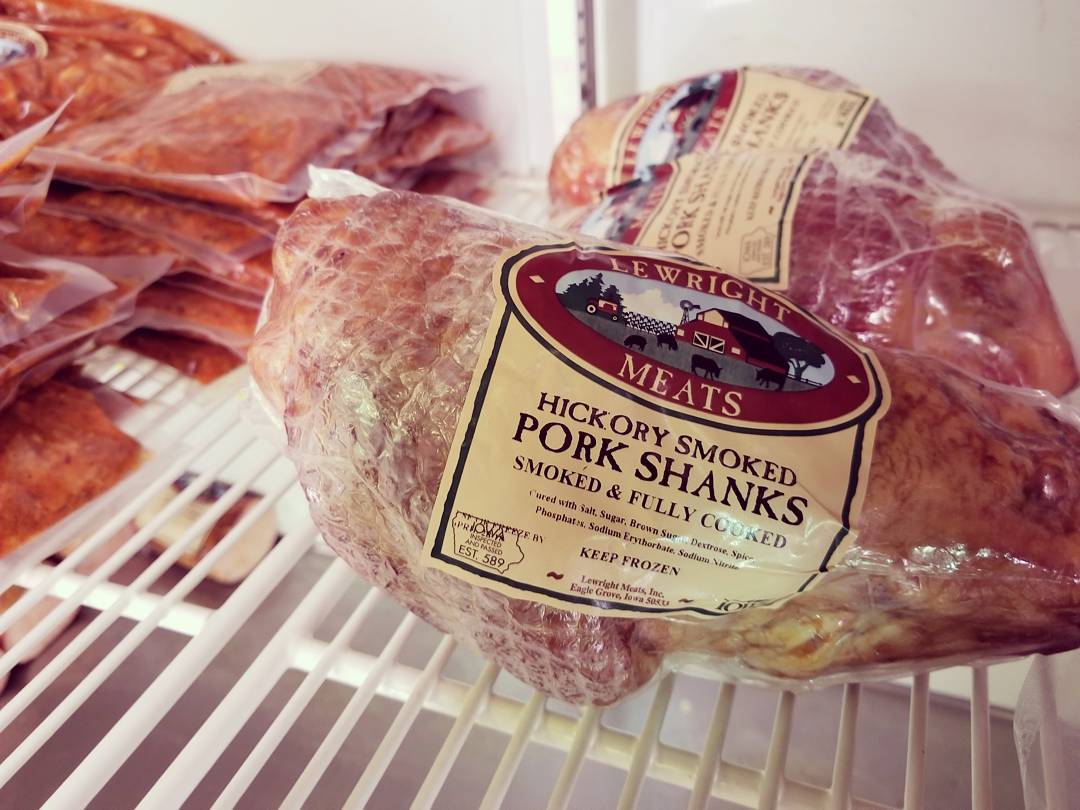
This smoked ham hock from Lewright Meats in Eagle Grove is the key to a great ham and bean soup.
The thing about ham and bean soup is that it can be a palette you fine-tune to your own tastes. Don’t like garlic? Leave it out. Want more onions in the mix? Add another one. (As my dear neighbor and farm cook extraordinaire Alice Ann Dial taught me, onions are a cheap way to add lots of flavor.)
The story behind Congress and Bean Soup
“Thunderation,” roared Speaker of the House Joe Cannon of Illinois. “I had my mouth set for bean soup! From now on, hot or cold, rain, snow, or shine, I want it on the menu every day.”
Obviously, ham and bean soup isn’t just a farm favorite. Turns out it has a rich history in the kitchens of Washington, D.C., too.
While ham and bean soup was a common item on the U.S. House of Representatives’ menu before the turn of the 20th century, it became a permanent fixture in the institution when Speaker Joe Cannon of Illinois discovered that his favorite meal had not been prepared by the kitchen staff on a hot, summer day in 1904.
Cannon, who was the namesake of the Cannon House Office Building, served in the U.S. House for 46 years. Dismayed by that egregious menu omission in 1904, the Speaker directed that bean soup be served in the House every day, regardless of the weather.
More than a century after Speaker Cannon’s decree, bean soup remains on the menu in the House Restaurant, making it one of the more longstanding and famous traditions in the House.
Members of the U.S. House aren’t the only fans of ham and bean soup. It’s also on the menu in the Senate’s restaurant every day. There are several stories about the origin of that mandate, but none has been corroborated.
According to one story, the Senate’s bean soup tradition began early in the 20th-century at the request of Senator Fred Dubois of Idaho. Another story attributes the request to Senator Knute Nelson of Minnesota, who expressed his fondness for the soup in 1903.
The recipe attributed to Dubois includes mashed potatoes and makes a 5-gallon batch. The recipe served in the Senate today does not include mashed potatoes, but does include a braised onion. Click here to check out both Senate recipes.
No matter how you like your ham and bean soup, here’s my take on this American classic. Enjoy, and let me know what you think.
Darcy’s Hearty Ham and Bean Soup
1 smoked ham hock (also called a smoked ham shank)—the meatier, the better
1 48-ounce jar great northern beans (I don’t drain and rinse the beans—I add it all)
3 stalks celery, diced
3 carrots, peeled and sliced
3 to 4 medium potatoes, diced (I prefer Yukon Golds)
1 large onion, chopped
1 tablespoon garlic, minced
1 teaspoon fresh-ground pepper
Water or chicken stock
Salt, to taste
Place ham hock in slow cooker. Add beans, celery, carrots, potatoes, onion, garlic and pepper. Cover with water or chicken stock until slow cooker is full. (If using water rather than chicken stock, I often add 2 or 3 teaspoons of Better Than Bouillon chicken soup base to add more flavor.)
Cook on low for 8 to 10 hours. (I often prepare the soup in the evening and let it cook overnight.) Remove ham hock, allow it to cool, and remove ham from the bone. Add ham back to the soup. Taste the soup to see if it needs salt. Add salt, if desired. (Some ham hocks add enough flavor to the broth that no salt is needed.)
• Note: homemade soup often develops more flavor if you let it sit in the refrigerator overnight and serve the soup the next day. This Hearty Ham and Bean Soup is so good, though, that I understand if you dig in right away!
P.S. Thanks for joining me. I’m glad you’re here.
Want more?
Thanks for stopping by. I invite you to read more of my blog posts if you value intriguing Iowa stories and history, along with Iowa food, agriculture updates, recipes and tips to make you a better communicator.
If you like what you see and want to be notified when I post new stories, be sure to click on the “subscribe to blog updates/newsletter” button at the top of this page, or click here. Feel free to share this with friends and colleagues who might be interested, too.
Also, if you or someone you know could use my writing services (I’m not only Iowa’s storyteller, but a professionally-trained journalist with 20 years of experience), let’s talk. I work with businesses and organizations within Iowa and across the country to unleash the power of great storytelling to define their brand and connect with their audience through clear, compelling blog posts, articles, news releases, feature stories, newsletter articles, social media, video scripts, and photography. Learn more at www.darcymaulsby.com, or e-mail me at yettergirl@yahoo.com.
If you’re hungry for more stories of Iowa history, check out my top-selling “Culinary History of Iowa: Sweet Corn, Pork Tenderloins, Maid-Rites and More” book from The History Press. Also take a look at my latest book, “Dallas County,” and my Calhoun County” book from Arcadia Publishing. Both are filled with vintage photos and compelling stories that showcase he history of small-town and rural Iowa. Order your signed copies today! Iowa postcards are available in my online store, too.
Let’s stay in touch. I’m at darcy@darcymaulsby.com, and yettergirl@yahoo.com.
Talk to you soon!
Darcy
@Copyright 2018 Darcy Maulsby & Co.

Quit Using “Stupid Language”
Pop quiz—would you rather use lots of junk words and jargon that don’t mean anything, or speak like a real person and be a great communicator? Even “The Bob and Tom Show” hosts have had enough of “stupid language.”
Yep, “stupid language” is the term that came up this week when Kristi Lee was reading news headlines on “The Bob and Tom Show” as I was driving to Mid-Iowa Cooperative to work on their newsletter.
Here’s a snippet from the Jan. 8, 2018, Circuit City press release that triggered a lively debate:
“Circuit City is set to announce official company relaunch at the 2018 Consumer Electronics Show in Las Vegas on Monday January 8th at 3:00 PM PST during a special press event. Circuit City is expected to announce its official launch concentrated on the retail verticals of e-commerce, mobile, technology, omni-channel commerce.”
Huh?
That’s what Kristi, Bob, Tom and other hosts were asking. What exactly are retail verticals and omni-channel commerce?
Some of the radio hosts argued that the audience would be familiar with these terms. Others weren’t so sure and asked a key question: why not just clearly say what you mean?

Bob and Tom Show photo from http://www.955glo.com/shows/bob-tom/.
It didn’t get any better as the press release droned on about “enhancing the product discovery journey” and “relaunching with a new agenda of enhancing shopping experiences with cutting-edge technology.”
All this just made Circuit City the butt of endless jokes (including the flippant remark “what a douchebag,” referring to company leadership) on “The Bob and Tom Show,” a nationally-syndicated radio show with millions of listeners. We all got the message when one host put it bluntly. “Quit using stupid language.”
I couldn’t agree more.
Communicating to clarify or confuse—take your pick
Whether you call it stupid language or jargon, it abounds nearly everywhere you go, from business to politics to agriculture. Sometimes it’s not all bad. Jargon (including acronyms) can enhance communication by eliminating unnecessary words—but this only works when everyone knows this insider language.
If I start talking about N, P, and K rates or VRT, other farmers will know immediately I’m referring to nitrogen, phosphorus and potassium fertilizer and variable-rate technology. This wouldn’t be obvious to non-farmers, though.
You venture into the realm of “stupid language” when your audience doesn’t understand what you’re trying to say, and you make no effort to spell it out. It’s easy to see why audiences view jargon, buzzwords and corporate-speak as signs that you don’t have a clear grasp of what you want to say—or a clear grasp of your subject.
But this is just the start of the unsettling reality.
As a trained journalist who has interviewed thousands of people in the past 20 years, I’ve learned there’s an even more troubling reason why some people use complex, confusing language. They think that if they dress things up in clever, convoluted concepts, they can deflect the tough questions that cut to the core of tough challenges that rarely have quick or straightforward answers.
It’s the old smoke-and-mirrors trick, and it’s deadly to communicating like a leader.
3 tips to avoid the “stupid language” trap
So how to do choose words that influence and inspire, rather than confuse? Here are my three top tips:
1. Always keep your audience top of mind. Effective communication is not about sounding smart—it’s about sharing a useful message that resonates with your audience. Listen to your audience. What do they want (or need) to know? What would improve their life, solve a problem, help them reach their goals? Since the Circuit City press release was apparently geared towards the media, there are actually two audiences here—reporters and their readers, listeners or viewers. Reporters want an interesting, newsworthy story. Their audience wants tech news that’s presented clearly and shows them how technology (and the companies that supply it) can make their life easier and more enjoyable. Since the big story here is the relaunch of a brand that many people thought was dead, I’d focus on how the comeback of Circuit City will benefit the company’s self-proclaimed target audience of “legacy Circuit City customers to Millennials.”
2. Use simple language. Why use a $1 word when a 10-cent word will do? This isn’t dumbing down the language. This is effective communication. In the case of the Circuit City press release, don’t assume that everyone hearing this message is an electronics expert or techie. Skip the jargon and tech-speak. Instead of “omni-channel commerce,” which isn’t a common term to many people, try, “We sell online and offline and wants to serve people wherever it’s convenient for them, whether that’s in a physical store, an online store or on social media.”
3. Tell a story to support your key point. “Just the facts, ma’am” may have worked for Detective Joe Friday in the classic “Dragnet” TV series, but the facts alone are rarely enough to captivate an audience. Think about it. When you go to party, you don’t walk up to a group of people and say, “I’m pleased to report that I optimized my marketing plan this week to monetize my business.” You tell people a story about what happened. They become intrigued and ask questions. They might even tell others, if the story is compelling enough. With this kind of an exchange, you’ve just accomplished one of communication’s toughest objectives–creating a story that passes the “So what? Who cares?” test.
The bottom line? Be conscious of the language you use when you communicate, whether it’s an e-mail, an article, a speech or a media interview. Putting these three proven tips to work will help you avoid the pitfall of “stupid language”—and that’s no joke.
P.S. Thanks for joining me. I’m glad you’re here.
Want more?
Thanks for stopping by. I invite you to read more of my blog posts if you value intriguing Iowa stories and history, along with Iowa food, agriculture updates, recipes and tips to make you a better communicator.
If you like what you see and want to be notified when I post new stories, be sure to click on the “subscribe to blog updates/newsletter” button at the top of this page, or click here. Feel free to share this with friends and colleagues who might be interested, too.
Also, if you or someone you know could use my writing services (I’m not only Iowa’s storyteller, but a professionally-trained journalist with 20 years of experience), let’s talk. I work with businesses and organizations within Iowa and across the country to unleash the power of great storytelling to define their brand and connect with their audience through clear, compelling blog posts, articles, news releases, feature stories, newsletter articles, social media, video scripts, and photography. Learn more at www.darcymaulsby.com, or e-mail me at yettergirl@yahoo.com.
If you’re hungry for more stories of Iowa history, check out my top-selling “Culinary History of Iowa: Sweet Corn, Pork Tenderloins, Maid-Rites and More” book from The History Press. Also take a look at my latest book, “Dallas County,” and my Calhoun County” book from Arcadia Publishing. Both are filled with vintage photos and compelling stories that showcase he history of small-town and rural Iowa. Order your signed copies today! Iowa postcards are available in my online store, too.
Let’s stay in touch. I’m at darcy@darcymaulsby.com, and yettergirl@yahoo.com.
Talk to you soon!
Darcy
@Copyright 2018 Darcy Maulsby & Co.
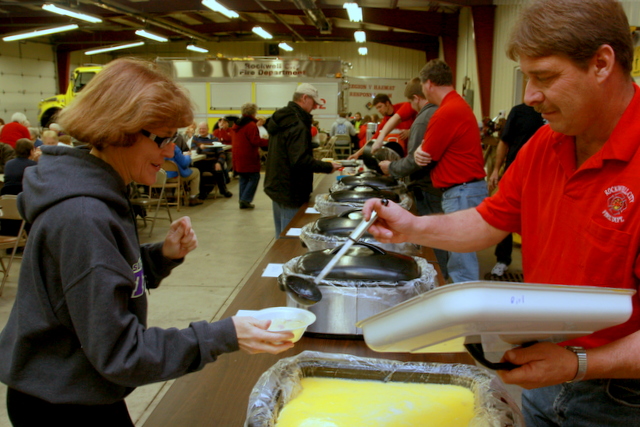
Mmm, Mmm Good: Soup’s on at the Rockwell City Fire Department
While soup is often considered little more than a prelude to something bigger, that’s not the case at the Rockwell City Fire Department. Throughout the winter, roasters filled with homemade chili, cheesy chicken noodle soup and other favorites make the fire station one of the hottest destinations in town.
“We typically serve 300 to 400 people at each supper,” said Duane Murley, a well-known farm broadcaster who has served on the Rockwell City Fire Department for 21 years. “Many times we have a line out the door.”
Murley and his fellow firefighter, Phil Hammen, co-chair the soup suppers, which are held the second Sunday of November, December, January and February from 4 p.m. to 6:30 p.m. at the fire station in Rockwell City. There’s no set fee to attend the soup suppers, which are supported by free-will donations.
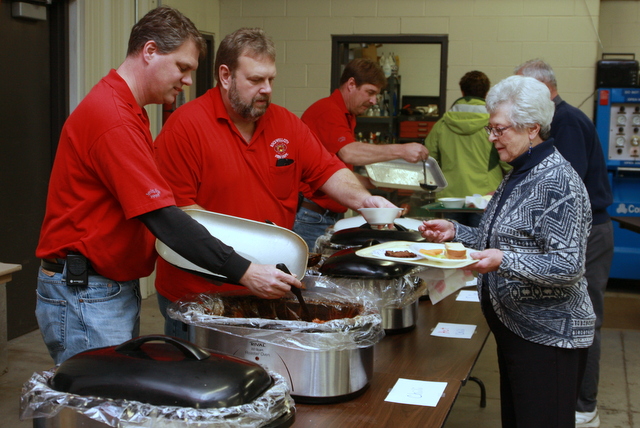
The volunteer firefighters serve two kinds of chili, cheesy chicken noodle soup, 8-Can Soup and more.
“This isn’t so much a money maker as it’s a way for the community to come together,” said Murley, who noted at the soup suppers have been held each winter for nearly seven years.
Many of the guests come from Rockwell City, Lake City, Manson and Twin Lakes. “I like to stop by and help support another local fire department,” said Josh Waller, who serves on the Manson Fire Department and the Calhoun County Farm Bureau board.
While each soup supper includes standard items such as potato soup and chili, the firefighters also mix things up with cheeseburger soup and other options. Each December, local supporters donate ingredients for the oyster stew, which is always a big hit. “They always have lots of good soup here and lots of variety,” said Toni Kerns of Rockwell City.
The firefighters often begin making their soups on Thursday or Friday before the Sunday soup supper. “The key to a good soup is to give it enough time to develop plenty of flavor,” said Phil Hammen, who co-chairs the soup suppers.
Perhaps the simplest—yet most talked-about—menu items are the famous lettuce sandwiches. These are just what they sound like—leaves of lettuce sandwiched between two slices of bread spread with mayonnaise or butter.
“These started as a joke,” said Murley, who recalled his mother-in-law’s stories of eating lettuce sandwiches during her school days at Jolley. “Now people look forward to them so much that we often use seven pounds or more of lettuce during our soup suppers.”
From the lettuce sandwiches to the homemade soups, the firefighters want guests to relax and reconnect with friends and family. “It’s not just about the food,” Murley said. “It’s about being part of the community.”
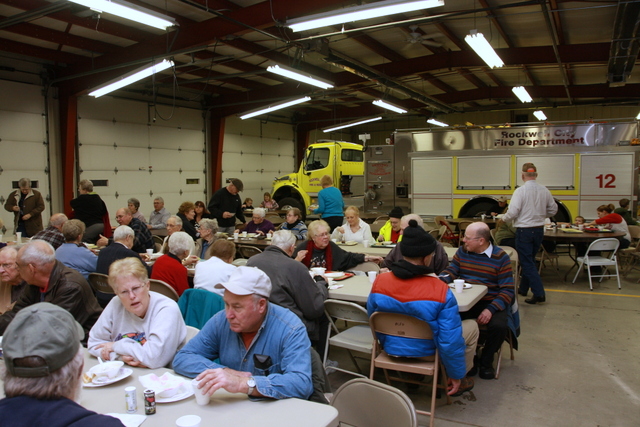
Cold Iowa winter nights don’t deter locals from enjoying the monthly soup suppers at the Rockwell City Fire Department.
8-Can Soup
People often ask if this flavorful soup really contains eight cans of ingredients. Yes it does, says Shane Voith, who has served as Rockwell City’s fire chief, who often multiplies this recipe by five to make this hearty soup for the soup supper.
1 can Hormel chili with beans
1 can Hormel chili, no beans
1 can sliced potatoes, undrained
1 can cut green beans, undrained
1 can whole-kernel corn, undrained
1 can mixed vegetables, undrained
1 can vegetable beef stew
1 can steak and potato soup
1 packet of powdered ranch dressing
Combine all ingredients in a large slow cooker, kettle or roaster. Cook on low all day, or for 2 to 3 hours on high to get the soup hot.
Sweet Chili
Jonathan Wetter, a Rockwell City volunteer firefighter, got this recipe from a friend. It’s reminiscent of both a sweet chili and calico beans.
Half a pound of bacon, cooked and diced
1 pound ground beef, browned
1 can lima beans, drained
1 can butter beans, drained
1 can kidney beans, undrained
1 can pork-and-beans, undrained
1 small onion, chopped
16-ounce can crushed pineapple
1 tablespoon mustard
4 tablespoons molasses
2 tablespoons vinegar
1 / 2 cup brown sugar
1 teaspoon Worcestershire sauce
1 / 2 cup ketchup
Combine all ingredients. Cook on low in a slow cooker or roaster for a few hours until hot.
Firehouse Chili
Duane Murley, co-chair of the fire department’s soup suppers, often makes three roasters of this chili, including one batch with hot peppers for a spicier chili.
7 pounds hamburger, browned
2 gallons Bush’s chili beans
2 gallons diced tomatoes
1 gallon tomato juice
Hot peppers, diced—optional
Cookies Flavor Enhancer, to taste
Chili powder, to taste
Combine all ingredients in a kettle, slow cooker or roaster. Cook on high for several hours or on low all day.
Potato Soup
Phil Hammen, co-chair the fire department’s soup suppers, specializes in this filling Potato Soup. This recipe makes enough to fill one roaster.
15 pounds potatoes, diced and boiled until tender
3 onions, diced
3 ham steaks, cubed
1 1 / 2 gallons 2% milk
2 sticks butter
Combine all ingredients in roaster. Cook until soup is heated through.
Cheesy Chicken Noodle Soup
This perennially popular soup is prepared by firefighter Kyle Welander of Rockwell City. When he cooks for the soup suppers, he boils eight whole chickens, removes the meat from the bones and saves the liquid to make homemade chicken broth.
1/4 cup butter, melted
1/4 cup flour
3 cups chicken broth
1 cup milk
2 cups Velveeta processed cheese, cubed
2 cups egg noodles, cooked
2 cups cooked, diced chicken
Melt butter in a large saucepan and add flour. Add chicken broth and milk. Cook, stirring occasionally on medium-high heat, until the mixture starts to bubble and thicken. Add cubed Velveeta cheese, and stir until melted. Pour mixture into larger pan or kettle. Add 2 cups of cooked egg noodles and 2 cups cooked, diced chicken. Cook on low. To fill a roaster, multiply this recipe by eight.
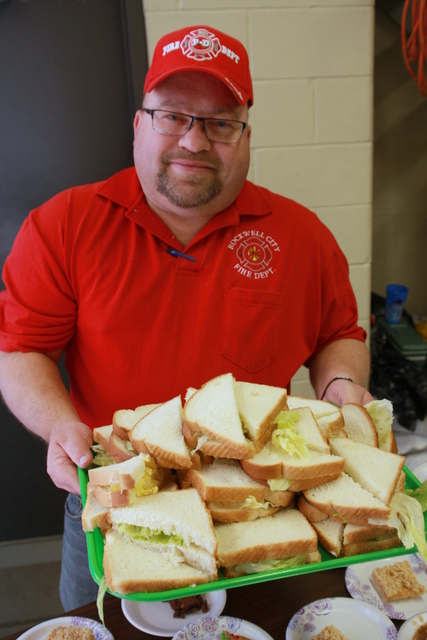
Calhoun County’s Famous Lettuce Sandwiches
Sliced bread
Mayonnaise or butter
Lettuce
Spread slices of bread with mayonnaise or butter. Top the bottom slice with a few leaves of lettuce. Add top slice of bread to complete the sandwich.
Lois Hensel’s Cake
Shelly Hammen of Rockwell City often makes desserts for the fire department’s soup suppers, including this incredible cake that was made famous by Lois Hensel, a long-time cake baker from Lake City. This recipe has been copied from a local cookbook.
2 packages Betty Crocker white cake mix, plus 1 1 / 2 cups from a third box of cake mix
7 / 8 cup egg whites
3 cups water
1 / 2 cup vegetable oil
1 1 / 2 teaspoons almond flavoring
1 / 2 teaspoon butter flavoring
Place cake mixes in mixer bowl. Add 2 cups of water and start mixing. Add egg whites, vegetable oil, almond flavoring, butter flavoring and remaining 1 cup of water. Continue mixing for 2-3 minutes until batter is smooth.
Line two sheet-cake pans (10.5 inches by 15.5 inches by 1 inch) with typing paper (paper may overlap). Pour half of the batter into the first pan. (This should weigh about 3.5 pounds or a bit more.) Place this pan on top oven rack. Bake 10 minutes at the recommended baking temperature on the cake mix box.
Stir the rest of the batter a bit with a spatula. Pour this batter into second cake pan. When first cake tests done (by a light touch of a finger) after about 20 minutes, remove cake from oven. Place second cake on top rack in oven. Bake until done.
Cool the first cake about 10 minutes, and run a knife around the four sides to loosen. Place a few layers of newspaper on both the cake top and on a bigger board. Holding securely, turn cake over onto the board, and peel liner paper off the cake. The brown on top of the cake will now adhere to the newspaper; peel off newspaper.
Place prepared board over cake, holding securely. Turn board and cake over, and place liner paper on cake. Place this in a plastic bag and freeze. It will be easy to trim the four sides with a serrated knife when cake is removed from the freezer.
Have icing ready. Stack four to five piece of 10.5-inch by 15-inch cardboard covered with tinfoil to hold each cake.
Lois Hensel’s Cake Icing
3 / 4 cup egg whites
4 pounds powdered sugar, divided
4 large “blobs” of Crisco shortening
1 teaspoon salt
1 / 2 cup water
1 teaspoon almond flavoring
1 / 2 teaspoon butter flavoring
1 / 2 teaspoon (or more) lemon flavoring
2 teaspoons clear vanilla
Place egg whites in mixer bowl. Add a pound of powdered sugar. Mix, and add shortening and salt. As you continue to mix, add water, remaining powdered sugar, almond flavoring, butter flavoring, lemon flavoring and clear vanilla. Don’t beat—just mix until smooth and until the right consistency is reached, scraping the sides of the bowl with a spatula. Add more powdered sugar, if needed.
This feature originally ran in Farm News.
P.S. Thanks for joining me. I’m glad you’re here.
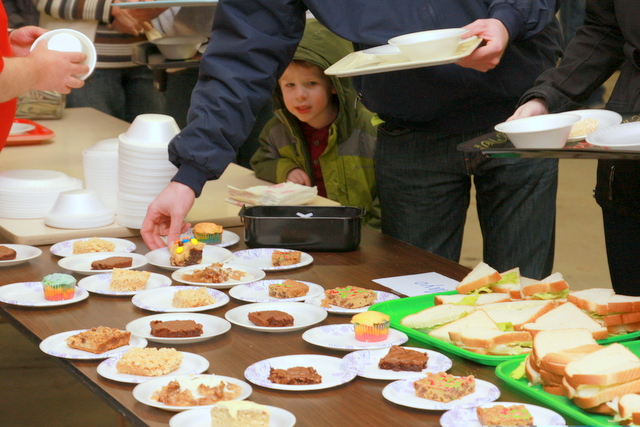
Everyone loves dessert at the soup supper.
Want more?
Thanks for stopping by. I invite you to read more of my blog posts if you value intriguing Iowa stories and history, along with Iowa food, agriculture updates, recipes and tips to make you a better communicator.
If you like what you see and want to be notified when I post new stories, be sure to click on the “subscribe to blog updates/newsletter” button at the top of this page, or click here. Feel free to share this with friends and colleagues who might be interested, too.
If you’re hungry for more stories of Iowa history, check out my top-selling “Culinary History of Iowa: Sweet Corn, Pork Tenderloins, Maid-Rites and More” book from The History Press. Also take a look at my latest book, “Dallas County,” and my Calhoun County” book from Arcadia Publishing. Both are filled with vintage photos and compelling stories that showcase he history of small-town and rural Iowa. Order your signed copies today! Iowa postcards are available in my online store, too.
Also, if you or someone you know could use my writing services (I’m not only Iowa’s storyteller, but a professionally-trained journalist with 20 years of experience), let’s talk. I work with businesses and organizations within Iowa and across the country to unleash the power of great storytelling to define their brand and connect with their audience through clear, compelling blog posts, articles, news releases, feature stories, newsletter articles, social media, video scripts, and photography. Learn more at www.darcymaulsby.com, or e-mail me at yettergirl@yahoo.com.
Let’s stay in touch. I’m at darcy@darcymaulsby.com, and yettergirl@yahoo.com.
Talk to you soon!
Darcy
@Copyright 2018 Darcy Maulsby & Co.
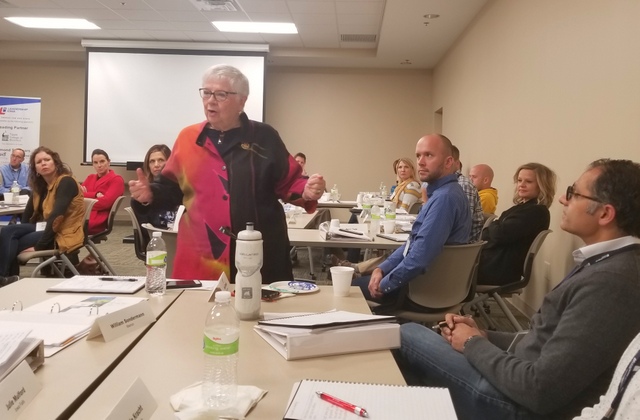
How Did We Get So Rude?
Ever come across something that takes on a deeper meaning every time you hear it? That’s how I felt when I scanned an online top 10 list of new year’s quotes and saw #8:
“Be at war with your vices, at peace with your neighbors and let every new year find you a better man.” — Benjamin Franklin
Seems like our society is increasingly mixing up the first two pieces of advice to the point where more people are at war with their neighbors and at peace with their vices, at least when it comes to rudeness. How did we get so rude? It made me think back to when I heard Mary Kramer articulate this pivotal issue.
I was in Winterset this fall when Kramer spoke to our class at Leadership Iowa, which is designed to instill passion in Iowa’s current and emerging leaders while fostering a high level of civic engagement. I saw a lot of heads nodding in agreement when Kramer, a former Republican state senator who was elected president of the Iowa Senate in 1997, tackled head-on the erosion of civil public discourse in America.
“We used to be able to debate with our adversaries without resorting to the demonization of one another,” said Kramer, a former United States Ambassador to Barbados and the Eastern Caribbean. “Back then, debates on important issues were challenging–even fun. Demonization used to be a last resort. Now we seem to begin with it.”
Demonization involves a shift from debating issues to attacking people. If we can destroy the career or the character of someone who is “getting it all wrong,” all would be well, or at least better.
It’s noxious process, Kramer stressed. Viewing those we disagree with as the embodiment of evil results in a profound loss of perspective on the humanity of our opponents. They stop being human beings like us, who happen to disagree on some issues.
Demonization isn’t limited to politics. It has spread like a cancer into entertainment, 24-hour news, social media and beyond. Its ubiquitous presence tempts people to cross the line between civility and rudeness without a second thought.
It also distorts reality. Just because someone passionately believe in something, does that belief allow him or her to mandate these views on everyone else?
No.
Not here, where generations of Americans have honored our heritage of meeting together, sharing information about a broad range of issues and seeking common ground. While our history isn’t one of perfect unity (far from it), we still found a way to move forward for the common good.
Let’s learn from the past and remind ourselves that the keys to combating this current rash of rudeness aren’t complex. They just require some human decency, a little kindness and a willingness to start with one key question: what problem are we trying to solve? I agree with Kramer that working together to agree on the problem statement often introduces common ground.
• Next, listen. Too often we underestimate the power of truly listening to others. Listen with curiosity, rather than “listening” with the intent to reply.
• Ask clarifying questions. Try to understand why people believe the way they do. Don’t just rush to judgement. Ask sincere (not snarky) questions, and try to discover what motivates someone to feel the way they do. As a writer who has interviewed thousands of people, I’m still sometimes shocked by the answers people give me. Plus, their viewpoints either challenge me to reconsider my own views or at least clarify why I believe what I believe.
• Acknowledge the validity of the other person’s position. While you don’t have to agree with someone’s viewpoint, you can and should acknowledge their position. Consider a controversial topic like water quality. Even if I don’t agree with someone’s opinion about the way to address this challenge, I can acknowledge this person’s concerns and validate the goal of clean, healthy drinking water.
Sure, not everyone who disagrees with you will follow this advice. Still, you’ve set the stage for more productive conversations, rather than head-on collisions propelled by rudeness.
Also, be encouraged by these words that Kramer came across years ago and shared with us at Leadership Iowa:
• Iowa is the place where the dream still lives.
• Iowa is the America we grew up believing in. It is liberty bought by hard work and integrity.
• It’s the belief that the future will be even better than today if we will work to make it that way.
So – can we talk? More important, can we listen?
This column originally appeared in January 2018 in Farm News.
P.S. Thanks for joining me. I’m glad you’re here.
Want more?
Thanks for stopping by. I invite you to read more of my blog posts if you value intriguing Iowa stories and history, along with Iowa food, agriculture updates, recipes and tips to make you a better communicator.
If you like what you see and want to be notified when I post new stories, be sure to click on the “subscribe to blog updates/newsletter” button at the top of this page, or click here. Feel free to share this with friends and colleagues who might be interested, too.
If you’re hungry for more stories of Iowa history, check out my top-selling “Culinary History of Iowa: Sweet Corn, Pork Tenderloins, Maid-Rites and More” book from The History Press. Also take a look at my latest book, “Dallas County,” and my Calhoun County” book from Arcadia Publishing. Both are filled with vintage photos and compelling stories that showcase he history of small-town and rural Iowa. Order your signed copies today! Iowa postcards are available in my online store, too.
Also, if you or someone you know could use my writing services (I’m not only Iowa’s storyteller, but a professionally-trained journalist with 20 years of experience), let’s talk. I work with businesses and organizations within Iowa and across the country to unleash the power of great storytelling to define their brand and connect with their audience through clear, compelling blog posts, articles, news releases, feature stories, newsletter articles, social media, video scripts, and photography. Learn more at www.darcymaulsby.com, or e-mail me at yettergirl@yahoo.com.
Let’s stay in touch. I’m at darcy@darcymaulsby.com, and yettergirl@yahoo.com.
Talk to you soon!
Darcy
@Copyright 2018 Darcy Maulsby & Co.
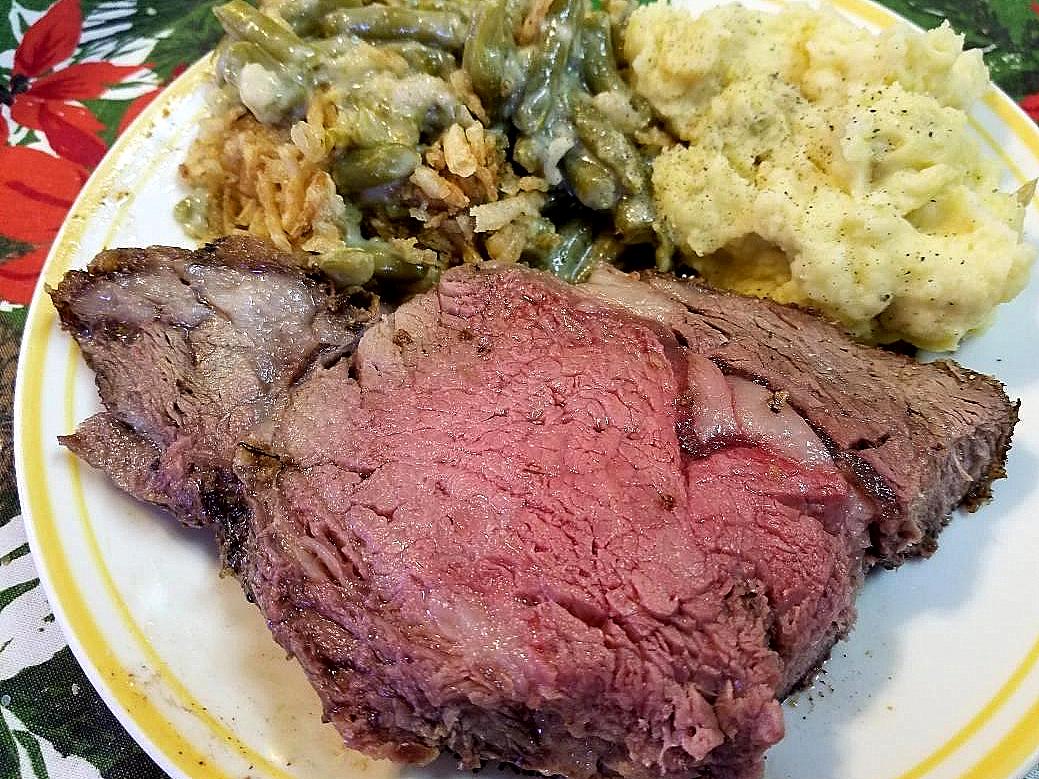
How to Cook a Perfect Prime Rib
Would you believe me if I told you restaurant-quality prime rib is one of the easiest main courses to prepare, plus you’ll look like a gourmet chef in the process? Yep, it’s true.
Take it from this Iowa farm girl. I adore the taste of prime rib. So tender, so robust, and bursting with all the flavor and juiciness that makes each bite a little trip to paradise.
When my family asked me to cook prime rib for New Year’s Day dinner, I didn’t hesitate. The prep couldn’t be simpler, and the results are simply spectacular. When you serve this delectable prime rib, your guests (possibly even the vegetarians) will be begging for more.
Let’s get cookin.’
Darcy’s Prime Rib
Select the right size roast. Allow at least 6 ounces of cooked, trimmed meat per adult. I cooked an 8-pound roast for our gathering, because I like to have leftovers. Beef and veggie soup, anyone?
Preheat the oven. Crank it up to 450 degrees Fahrenheit, and let it heat up for about 30 minutes. Also, you can remove the beef roast from the refrigerator at this time.
Gather your supplies. I recommend a metal roasting pan with a rack (like the one you might use to cook at turkey), olive oil, kosher salt, and fresh-ground pepper. Oh, and don’t forget to round up some soap and wash your hands thoroughly. We’re in the kitchen prepping food, after all!

Rachet-style pepper mill in red!
• A side note about fresh-ground pepper. I LOVE my Kuhn Rikon® high-output ratchet mill. (Check out a video here to see it in action). I appreciate the easy and speed of these wonder gadgets, plus I adore the red color of my pepper mill, since it matches my kitchen. One more thing—don’t think you’re limited to filling it with black peppercorns only. After interviewing a chef years ago about how to amp up the flavor in any dish, I took his advice and use of mix of peppercorns, including black, green, red and white, which bring a different flavor to the party.
Season the beef. Follow the K.I.S.S. method (keep it simple stupid). Prime rib roast doesn’t need a marinade or any complicated preparations, since the meat speaks for itself. Drizzle olive oil on the roast. Spread it around the roast with your hands. Next, liberally rub kosher salt and plenty of fresh-ground pepper on the meat. I don’t measure—I just go with what looks right.
If you’re thinking about using an herb mix to season the meat, I say go right ahead. I like to use this homemade herb blend that I learned to make at my dear friend Shannon Latham’s Enchanted Acres pumpkin patch near Sheffield, Iowa. I’m a big fan of the recipe here for Save Summer in a Jar Herb-Salt Mix and used it on my New Year’s prime rib–divine! Thanks to my friend Mary Lovstad of Farm Girl Cook’n in northern Iowa for all the inspiration!
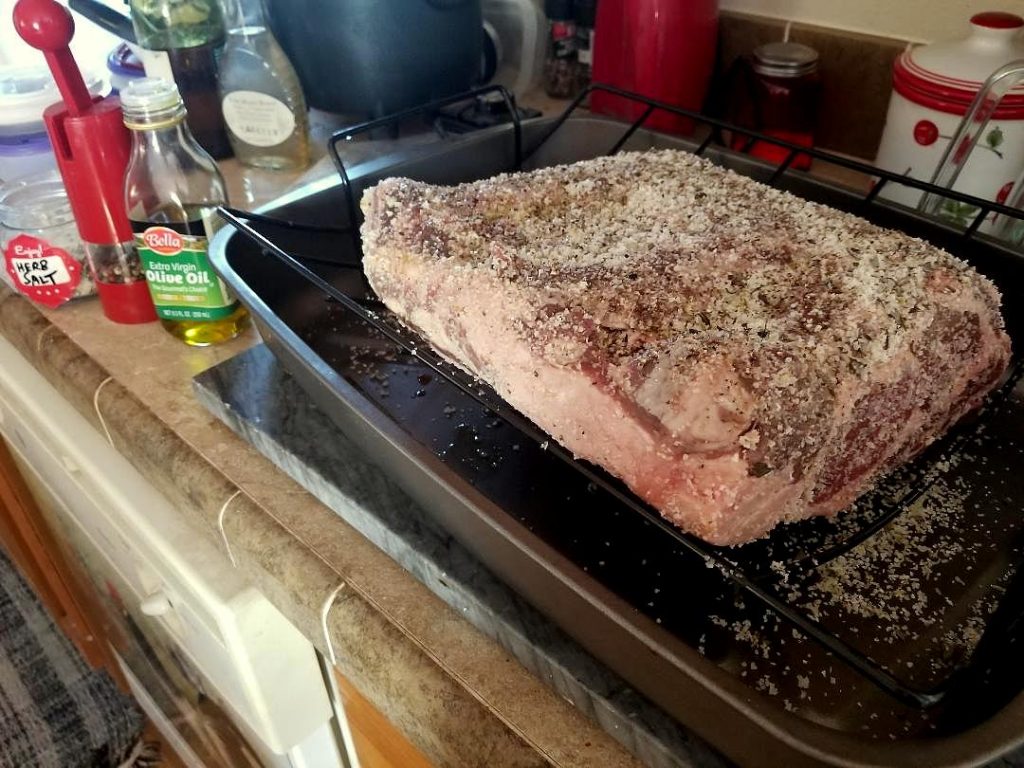
Dry rubs enhance any beef roast
Bake. Place the meat in a roasting pan that’s slightly bigger than the roast itself. I like a roasting pan and roasting rack, myself. Note–one side of the meat will have more fat on it. You want the fatty side facing up so the meat will baste itself as it cooks.
Finally, don’t add water to the pan, and don’t cover the roast. Just pop it in in the oven.
Timing is everything. How long does it take to cook a prime rib? Well, it depends. I like to start with a high temperature (450 degrees) for the first 30 minutes. Then I drop the heat to 325 degrees and allow about 13 to 15 minutes of cooking time per pound of beef.
DO NOT keep opening the oven door to check the meat. Just enjoy the tempting sizzle as the pan drippings appear during the first phase of cooking. Then savor the aromas as the beef finishes cooking over the next few hours.
A thermometer is the best way to guarantee the roast turns out exactly the way you want it. For an accurate reading, push the thermometer into the middle of the roast, making sure the tip is not touching fat or bone (or the pan). FYI–medium rare is about 130 degrees F. If that’s what you’re going for (confession–it’s my personal favorite), take the meat out of the oven when it’s around 120 degrees F. Remember that the roast’s temperature will rise at least 5 degrees after you remove it from the oven.
Let it rest. Warning—the prime rib will look incredible when you pull it out of the oven, but resist the urge to carve it right away. Let this meaty masterpiece rest for 15 or 20 minutes before carving to let the juices return to the center. Cover the roast with a “tent” of tinfoil. (If you’re at my house, be warned. My dog, Maggie the Red Heeler, is obsessed with tinfoil and will bark like a maniac when I tear a sheet of foil from the roll. Silly dog.)
With prime rib, it’s easy to satisfy everyone’s preference for doneness. The slices taken from the ends of the roast will be the most done, and the middle will be the least done.
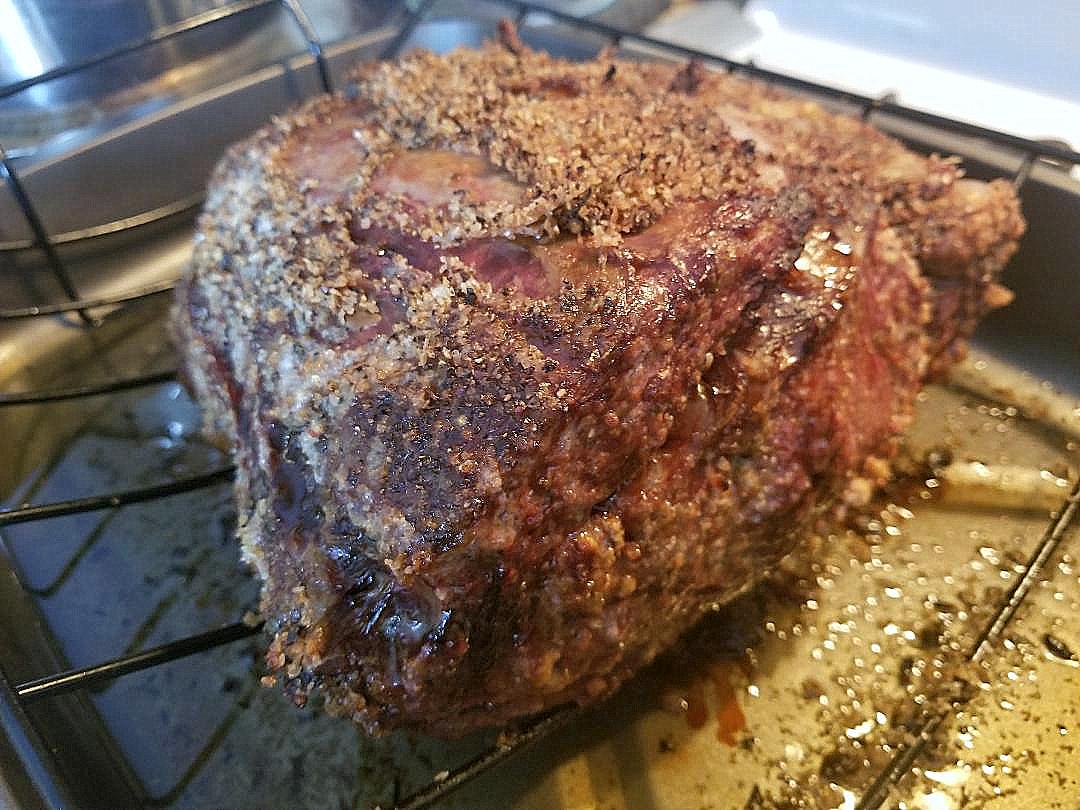
Prime rib right out of my oven
Add a little something extra. When the roast is done make sure you use the drippings in the bottom of the pan to make gravy. Then you’ll have a head-start on the most flavor-packed beef stew you can imagine.
Next time I prepare a prime rib, I’m going to try Food Network Chef Bobby Flay’s idea for Prime Rib with Thyme au Jus. Here’s what he recommends:
Place the roasting pan on top of the stove over 2 burners set on high heat. Add the wine to the pan drippings in the pan and cook over high heat until reduced, scraping the bottom of the pan with a wooden spoon. Add the stock and cook until reduced by half. Whisk in the thyme and season with salt and pepper, to taste.
Tell me all about it. Bottom line? Do not fear cooking prime rib, even though this is a pricey cut. You can do this! When you do, be sure to leave a comment, e-mail me, post on social media and tell me all about it.
Did you know?
“Prime rib” is not a specific cut of beef but is actually a preparation method for a beef rib roast. If you know the standard meat roasting method, you can make prime rib out of several types of beef rib roasts, according to my friends at the Iowa Beef Industry Council.
Check out their handy Beef Roast Basics guide. You’ll find tips on how to know what size beef roast to purchase, how to carve meat like a pro and more.

How’s this for a plate of prime rib perfection?
More reasons why beef is good
With my background as an ag journalist, I love to highlight agriculture, especially Iowa agriculture. Why do we know beef here in the Heartland? Because Iowa is in the top 10 beef-producing states in America, terms of all cattle and calves (ranking #7).
Here’s a snapshot of Iowa’s beef industry, which is a powerhouse in terms of economic development and providing a safe, nutritious product that nourishes people around the world:
- Total cattle inventory in Iowa (as of January 1, 2017): 3,850,000
- Number of feedlots (2012 Census): 6,036
- Number of cattle operations (2012 Census): 26,827
- Number of farms with beef cows (2012 Census): 19,677
- Iowa jobs directly related to the cattle industry (2015): 20,690
- Iowa jobs indirectly related to the cattle industry (2015): 7,384
- In 2015, Iowa’s cattle industry contributed more than $6.9 billion in business activity to Iowa’s economy.* Sources: Department of Economics, Iowa State University; Iowa Agricultural Statistics, U.S. Department of Agriculture; 2017 Cattle Inventory Report National Agricultural Statistics Service (NASS), Agricultural Statistics Board, United States Department of Agriculture (USDA).
Can’t get enough beef?
There’s no such thing as too much beef if you love it as much as I do. I think my friend Larry Irwin would agree, especially when it comes to hamburgers.
Make no mistake, the humble hamburger still reigns supreme from backyard barbecues to fast-food drive-ins across Iowa. But this Iowa icon also provides the perfect palette for culinary creativity when Larry Irwin showcases his Burger of the Month flavors in my hometown of Lake City. Get the story and the recipes here.
Also, get your grill on and build a better burger with my top tips.
Finally, I just had to share this photo below. My relatives in Webster County, the Walrod family, did extremely well on the show circuit this year with their beef cattle and took top honors with their Limousin cattle at the Iowa State Fair. Why not decorate the Christmas tree to celebrate a banner year?
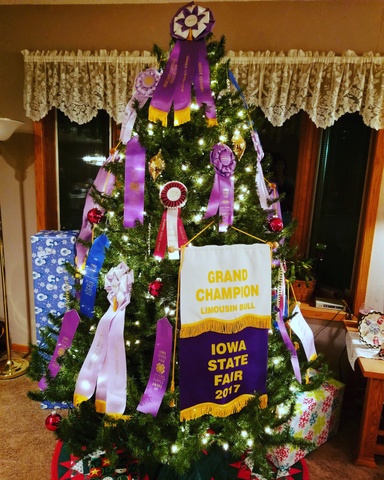
Cattle banners on the Christmas tree in Iowa
Want more?
Thanks for stopping by. I invite you to read more of my blog posts if you value intriguing Iowa stories and history, along with Iowa food, agriculture updates, recipes and tips to make you a better communicator.
If you like what you see and want to be notified when I post new stories, be sure to click on the “subscribe to blog updates/newsletter” button at the top of this page, or click here. Feel free to share this with friends and colleagues who might be interested, too.
If you’re hungry for more stories of Iowa history, check out my top-selling “Culinary History of Iowa: Sweet Corn, Pork Tenderloins, Maid-Rites and More” book from The History Press. Also take a look at my latest book, “Dallas County,” and my Calhoun County” book from Arcadia Publishing. Both are filled with vintage photos and compelling stories that showcase he history of small-town and rural Iowa. Order your signed copies today! Iowa postcards are available in my online store, too.
Also, if you or someone you know could use my writing services (I’m not only Iowa’s storyteller, but a professionally-trained journalist with 20 years of experience), let’s talk. I work with businesses and organizations within Iowa and across the country to unleash the power of great storytelling to define their brand and connect with their audience through clear, compelling blog posts, articles, news releases, feature stories, newsletter articles, social media, video scripts, and photography. Learn more at www.darcymaulsby.com, or e-mail me at yettergirl@yahoo.com.
Let’s stay in touch. I’m at darcy@darcymaulsby.com, and yettergirl@yahoo.com.
Talk to you soon!
Darcy
P.S. Thanks for joining me. I’m glad you’re here.
@Copyright 2018 Darcy Maulsby & Co.

Free Gifts! (Let’s Talk Listening, Stories and History)
Are you ready for Christmas? I’m not, and I’m totally ok with that.
Yep, I’ve still got baking to do, my house is messy (no surprise) and I barely got the Christmas tree up at a respectable time. One bright spot? I’ve got a pretty good handle on gifts, thanks to my travels across Iowa. I don’t stop with tangible gifts, though. As someone who believes in communicating like a leader and preserving history, I know many of the most meaningful gifts go far beyond items you can buy in the store. Best of all, these gifts are free and can be replenished anytime.
This year, be sure to give:
• The gift of listening. Remember how you felt the last time someone really listened to you? It’s so powerful, especially in this age of digital distractions. There’s something about being heard—truly heard—that fulfills a deep-seated human need for connection. It’s a bonus that listening also offers a great way to learn.
• The gift of stories. Humans also have a deep-seated need for stories. Our brains are wired to remember stories much more that data and facts. Plus, stories can be fun. Not sure where to start? Share stories of your favorite Christmas memories to start a conversation. Since I’m a food writer, you can bet many of my stories revolve around food. Here’s a goodie from my archives about how Lake City’s Shakespeare Club, of which I’m a member, has maintained good taste in small-town Iowa for more than 123 years. (Don’t miss the recipes for my Healthy Corn Tortellini Chowder, Cheesy Artichoke Dip and a festive Celebration Slush.)
• The gift of history. Speaking of memories, pull out the old family photo albums (please tell me you still have some around, right?), or watch your vintage home movies, and have a blast remembering the way you were. I guarantee younger generations will get a kick out of seeing your swinging ‘60s vibe, your ‘70s disco style, your ‘80s mullet or whatever defined your look back in the day. I also love sharing resources that bring history to life with stories and images. Maybe that’s why I’m such a huge fan of Coca Cola Journeys, in which Coca Cola’s top-notch team shares the most interesting stories ranging from storied history of Notre Dame football (and the Coca-Cola connection) to The Story of the Coca-Cola Polar Bears: How Man’s Best Friend Provided the Creative Inspiration Behind the Beloved Icons.
Enjoy these free gifts, my friends, and share the gifts of listening, stories and history with others, not just during the holidays, but year-round.
Have any stories or family history you like to share, especially during the holiday season? Feel free to start the conversation here. I’m listening!
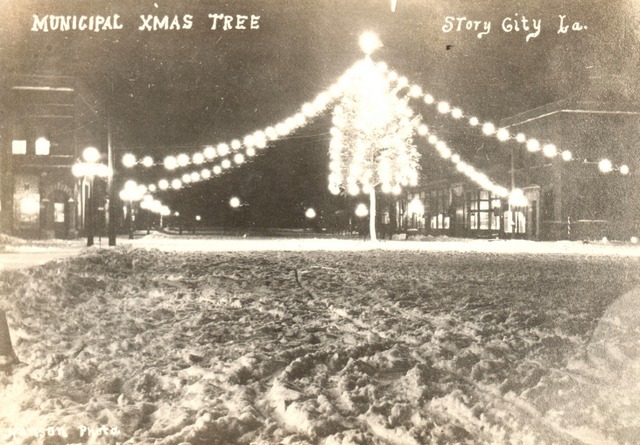
Yep, Iowans love to put Christmas trees in the middle of the street, and many communities have been doing this for generations. Click on the photo for the whole story.
Want more?
Thanks for stopping by. I invite you to read more of my blog posts if you value intriguing Iowa stories and history, along with Iowa food, agriculture updates, recipes and tips to make you a better communicator.
If you like what you see and want to be notified when I post new stories, be sure to click on the “subscribe to blog updates/newsletter” button at the top of this page, or click here. Feel free to share this with friends and colleagues who might be interested, too.
If you’re hungry for more stories of Iowa history, check out my top-selling “Culinary History of Iowa: Sweet Corn, Pork Tenderloins, Maid-Rites and More” book from The History Press. Also take a look at my latest book, “Dallas County,” and my Calhoun County” book from Arcadia Publishing. Both are filled with vintage photos and compelling stories that showcase he history of small-town and rural Iowa. Order your signed copies today! Iowa postcards are available in my online store, too.
Also, if you or someone you know could use my writing services (I’m not only Iowa’s storyteller, but a professionally-trained journalist with 20 years of experience), let’s talk. I work with businesses and organizations within Iowa and across the country to unleash the power of great storytelling to define their brand and connect with their audience through clear, compelling blog posts, articles, news releases, feature stories, newsletter articles, social media, video scripts, and photography. Learn more at www.darcymaulsby.com, or e-mail me at yettergirl@yahoo.com.
Let’s stay in touch. I’m at darcy@darcymaulsby.com, and yettergirl@yahoo.com.
Talk to you soon!
Darcy
P.S. Thanks for joining me. I’m glad you’re here.
@Copyright 2018 Darcy Maulsby & Co.


